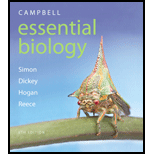
Concept explainers
You look into a microscope and view an unknown cell. What might you see that would tell you whether the cell is prokaryotic or eukaryotic?
- a. a rigid cell wall
- b. a nucleus
- c. a plasma membrane
- d. ribosomes
Introduction:
The cell can be defined as the functional, structural, and building unit of the living organisms. Basically, all the cells that exist on the Earth can be categorized into two different kinds, namely prokaryotes and eukaryotes.
Answer to Problem 1SQ
Correct answer:
Prokaryotic cells lack the double membrane structures, whereas eukaryotic cells possess double membrane–bound organelles such as the nucleus. Therefore, option b. is correct.
Explanation of Solution
Reasons for the correct statement:
All the cells have deoxyribonucleic acid (DNA) as the genetic material. DNA in prokaryotic cells is confined to a small region known as the nucleoid, and it is not membrane bound.
Eukaryotes have double membrane–bound structures including the nucleus, whereas prokaryotes lack any double membrane–bound structure. The membrane surrounding the nucleus is known as the nuclear membrane. The majority of the genetic material of eukaryotes is confined inside the nucleus.
Option b. is given as “a nucleus”.
The statement, “the nucleus is the structure which is present in the eukaryotes and not in the prokaryotes” is the right answer.
Hence, option b. is correct.
Reasons for the incorrect statements:
Option a. is given as “a rigid cell wall”.
A cell wall is a structure surrounding the cell and it provides the structural support to a cell. It is present in most of the prokaryotes and in some eukaryotes, including algae, fungi, and plants. Hence, it is a wrong answer.
Option c. is given as “a plasma membrane”.
The plasma membrane is a selectively permeable structure, which separates the exterior of the cell from the interior. Both prokaryotes and eukaryotes possess the plasma membrane. Hence, it is a wrong answer.
Option d. is given as “ribosomes”.
Ribosomes are the structures that are composed of ribonucleic acid (RNA) and proteins. Ribosomes play role in the synthesis of proteins. Prokaryotes have 70S (sedimentation coefficient) ribosomes, whereas eukaryotes have 80S ribosomes. Hence, it is a wrong answer.
Hence, options a, c, and d are incorrect.
The nucleus is present only in the eukaryotic cells and this double membrane–bound organelle is absent in prokaryotic cells. Thus, the presence of a nucleus can be utilized as a distinguishing feature to determine whether the unknown cell viewed under a microscope is prokaryotic or eukaryotic.
Want to see more full solutions like this?
Chapter 4 Solutions
Campbell Essential Biology (6th Edition) - standalone book
Additional Science Textbook Solutions
Biological Science (6th Edition)
Chemistry & Chemical Reactivity
Laboratory Manual For Human Anatomy & Physiology
Genetics: From Genes to Genomes
EBK INTRODUCTION TO CHEMISTRY
- How is a protein destined for the Endoplasmic Reticulum (ER), imported into the ER? Be concise.arrow_forwardFind out about the organisations and the movements aimed at the conservation of our natural resources. Eg Chipko movement and Greenpeace. Make a project report on such an organisation.arrow_forwardWhat are biofertilizers and mention the significancearrow_forward
- PCBs and River Otters: Otters in Washington State’s Green-Duwamish River have high levels of polychlorinated biphenyls (PCBs) in their livers. PCBs can bind to the estrogen receptors in animals and disrupt the endocrine system of these otters. The PCBs seem to increase the estrogen to androgen ratio, skewing the ratio toward too much estrogen. How would increased estrogen affect the river otter population? Based on your reading of the materials in this unit, what factors can affect fertility in humans? Explain how each of the factors affecting human fertility that you described can disrupt the human endocrine system to affect reproduction.arrow_forwardOther than oil and alcohol, are there other liquids you could compare to water (that are liquid at room temperature)? How is water unique compared to these other liquids? What follow-up experiment would you like to do, and how would you relate it to your life?arrow_forwardSelection of Traits What adaptations do scavengers have for locating and feeding on prey? What adaptations do predators have for capturing and consuming prey?arrow_forward
- Competition Between Species What natural processes limit populations from growing too large? What are some resources organisms can compete over in their natural habitat?arrow_forwardSpecies Interactions Explain how predators, prey and scavengers interact. Explain whether predators and scavengers are necessary or beneficial for an ecosystem.arrow_forwardmagine that you are conducting research on fruit type and seed dispersal. You submitted a paper to a peer-reviewed journal that addresses the factors that impact fruit type and seed dispersal mechanisms in plants of Central America. The editor of the journal communicates that your paper may be published if you make ‘minor revisions’ to the document. Describe two characteristics that you would expect in seeds that are dispersed by the wind. Contrast this with what you would expect for seeds that are gathered, buried or eaten by animals, and explain why they are different. (Editor’s note: Providing this information in your discussion will help readers to consider the significance of the research).arrow_forward

 Biology 2eBiologyISBN:9781947172517Author:Matthew Douglas, Jung Choi, Mary Ann ClarkPublisher:OpenStax
Biology 2eBiologyISBN:9781947172517Author:Matthew Douglas, Jung Choi, Mary Ann ClarkPublisher:OpenStax Concepts of BiologyBiologyISBN:9781938168116Author:Samantha Fowler, Rebecca Roush, James WisePublisher:OpenStax College
Concepts of BiologyBiologyISBN:9781938168116Author:Samantha Fowler, Rebecca Roush, James WisePublisher:OpenStax College





